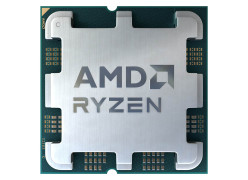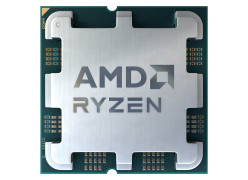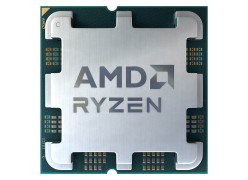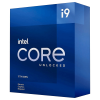1
- 25 Products of 159

AMD
100-000001368
AMD Ryzen 9 9900X3D AM5 Tray
Warranty: 3 Years
AMD Ryzen 9 9900X3D AM5 Tray 100-000001368. A powerful desktop CPU, with 2nd gen AMD 3D V-Cache Technology for you to enjoy extreme performance for gaming, creating, streaming or any workload you choose.

AMD
100-000001591
AMD Ryzen 5 8400F AM5 Tray
Warranty: 3 Years
AMD Ryzen 5 8400F AM5 Tray 100-000001591 is the starting point for PC gaming processors.

AMD
100-000001845
AMD Ryzen 5 7400F AM5 Tray
Warranty: 3 Years
AMD Ryzen 5 7400F AM5 Tray, Great Gaming Performance and Value. 100-000001845

AMD
100-000000719
AMD Ryzen 9 9950X3D AM5 Tray
Warranty: 3 Years
AMD Ryzen 9 9950X3D AM5 Tray Gaming and Content Creation Processor 100-000000719. The ultimate 16-core desktop CPU with 2nd gen AMD 3D V-Cache Technology that can do it all with incredible performance for the most demanding gamers and creators.

AMD
100-100001368WOF
AMD Ryzen 9 9900X3D AM5 Box
Warranty: 3 Years
AMD Ryzen 9 9900X3D AM5 Box 100-100001368WOF. A powerful desktop CPU, with 2nd gen AMD 3D V-Cache Technology for you to enjoy extreme performance for gaming, creating, streaming or any workload you choose.

Intel
C285T
Intel Core Ultra 9 285 / 1851 Tray
Warranty: 3 Years
Intel Core Ultra 9 Processor 285 1851 Tray C285T. 36M Cache, up to 5.60 GHz

Intel
C285B
Intel Core Ultra 9 285 / 1851 Box
Warranty: 3 Years
Intel Core Ultra 9 285 / 1851 Box. C285B

Intel
C265T
Intel Core Ultra 7 265 / 1851 Tray
Warranty: 3 Years
Intel Core Ultra 7 Processor 265 1851 Tray C265T. 30M Cache, up to 5.30 GHz

Intel
C265FT
Intel Core Ultra 7 265F / 1851 Tray
Warranty: 3 Years
Intel Core Ultra 7 Processor 265F 1851 Tray C265FT. 30M Cache, up to 5.30 GHz

Intel
C245T
Intel Core Ultra 5 245 / 1851 Tray
Warranty: 3 Years
Intel Core Ultra 5 Processor 245 1851 Tray C245T. 24M Cache, up to 5.10 GHz

Intel
C225FT
Intel Core Ultra 5 225F / 1851 Tray
Warranty: 3 Years
Intel Core Ultra 5 Processor 225F 1851 Tray C225FT. 20M Cache, up to 4.90 GHz

Intel
C225T
Intel Core Ultra 5 225 / 1851 Tray
Warranty: 3 Years
Intel Core Ultra 5 Processor 225 1851 Tray C225T. 20M Cache, up to 4.90 GHz

Intel
C235T
Intel Core Ultra 5 235 / 1851 Tray
Warranty: 3 Years
Intel Core Ultra 5 Processor 235 1851 Tray C235T. 24M Cache, up to 5.00 GHz

AMD
100-100001721WOF
AMD Ryzen 5 7600X3D AM5 Box
Warranty: 3 Years
AMD Ryzen 5 7600X3D Desktop Processor, Get the 6-core gaming processor with AMD 3D V-Cache Technology built for intense gaming action. 100-100001721WOF

AMD
100-000001084
AMD Ryzen 7 9800X3D AM5 Tray
Warranty: 3 Years
AMD Ryzen 7 9800X3D AM5 Tray, Enjoy faster gaming with 2nd gen AMD 3D V-Cache technology for low latency. 100-000001084

AMD
100-000001277
AMD Ryzen 9 9950X AM5 Tray
Warranty: 3 Years
AMD Ryzen 9 9950X AM5 Tray 100-000001277

AMD
100-000000662
AMD Ryzen 9 9900X AM5 Tray
Warranty: 3 Years
AMD Ryzen 9 9900X AM5 Tray 100-000000662. The Incredibly Powerful Processor for Gaming and Streaming.

Intel
C285KB
Intel Core Ultra 9 285K / 1851 Box
Warranty: 3 Years
Intel Core Ultra 9 Processor 285K 36M Cache, up to 5.70 GHz C285KB

Intel
C285KT
Intel Core Ultra 9 285K / 1851 Tray
Warranty: 3 Years
Intel Core Ultra 9 Processor 285K 36M Cache, up to 5.70 GHz C285KT

Intel
C265KT
Intel Core Ultra 7 265K / 1851 Tray
Warranty: 3 Years
Intel Core Ultra 7 Processor 265K 30M Cache, up to 5.50 GHz C265KT

Intel
C265KFT
Intel Core Ultra 7 265KF / 1851 Tray
Warranty: 3 Years
Intel Core Ultra 7 Processor 265KF 30M Cache, up to 5.50 GHz C265KFT

Intel
C245KB
Intel Core Ultra 5 245K / 1851 Box
Warranty: 3 Years
Intel Core Ultra 5 Processor 245K 24M Cache, up to 5.20 GHz C245KB

Intel
C245KT
Intel Core Ultra 5 245K / 1851 Tray
Warranty: 3 Years
Intel Core Ultra 5 Processor 245K 24M Cache, up to 5.20 GHz C245KT

Intel
C245KFB
Intel Core Ultra 5 245KF / 1851 Box
Warranty: 3 Years
Intel Core Ultra 5 Processor 245KF 24M Cache, up to 5.20 GHz C245KFB
Last Update: 17/09/2025 19:36
CPU - Buy Powerful Processors for Your PC.
Our CPU section, where you can find a wide range of high-performance processors for your desktop. Whether you are building a new system or upgrading an existing one, we offer top-quality CPUs from leading brands like Intel and AMD. Our selection includes processors suitable for all needs, from gaming and content creation to everyday computing.
Our catalog offers options for every budget, allowing both professionals and hobbyists to find the perfect processor for their projects. We take pride in providing the best prices on CPUs, making it easier for you to enhance your computer's performance without breaking the bank.
Shopping with us is straightforward and convenient. Our user-friendly website allows you to browse through our extensive inventory, compare products, and make informed decisions. Plus, with our fast and reliable delivery service across Israel, you can get your new CPU quickly and start enjoying enhanced performance right




